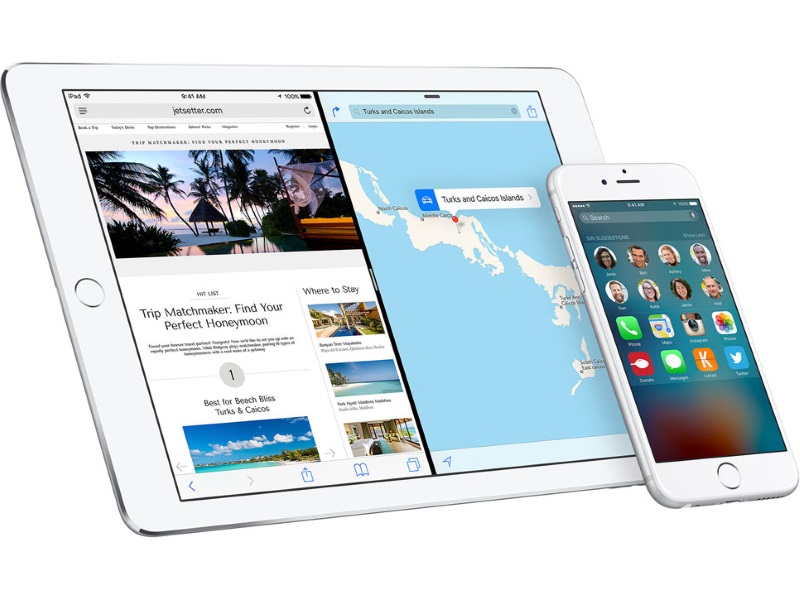Apple's iPhones and iPads are getting free software updates Wednesday,
including battery improvements and a smarter virtual assistant.
The
new features and capabilities in the update, iOS 9, are primarily
refinements rather than anything transformative. But the new software is
still worth getting, especially as new apps often require the latest
version to work.
Apple Watch was also supposed to get a software
update Wednesday, but that got delayed because Apple found a bug. A
separate Mac update, known as El Capitan, is coming out this fall.
Here are some things to know about Wednesday's updates:
(Also see: 15 iOS 9 Features That Make Your iPhone and iPad Better Than Ever)
On the iPhone
Although
some features such as 3D Touch contextual menus will require the new
iPhones that are coming next week, existing devices will get:
1. Battery life
Besides under-the-hood improvements, a new low-power mode
will reduce or turn off non-essential tasks such as visual effects and
automatic downloads. The phone also won't check for new mail or update
content for apps in the background as often.
2. Navigation
From
the main home screen, swipe left to right for a new search screen. The
Siri virtual assistant suggests frequently used contacts and apps and
nearby businesses, taking into account whether it's evening or lunch
time. As you jump around from app to app, some apps show a new back
button on the top left corner to get you back to what you were doing.
3. Notifications
Swipe down from the top edge for missed notifications,
with the most recent on top. Before, they were grouped by app, so you
had to sift through weeks-old notifications from little-used apps to
find the new ones. You can restore grouping by app in the settings.
4. Sleeping in
If you choose a particular song as your alarm sound, the
song will keep playing until you turn off the alarm or hit snooze.
Before, the alarm automatically stops once the song ends, even if you
didn't hear it. Now, you'll hear it over and over - though that might
just encourage you to stay in bed.
5. Security
If you have a new
device with fingerprint ID, you'll be asked to create a longer passcode
as a backup, with six digits instead of four. Because you'll need to
enter your passcode less often, it might as well be stronger. The
four-digit passcode won't change if you're simply upgrading rather than
setting up a new device.
6. Getting there
Apple Maps gets transit
directions in major cities, addressing a major omission. In some cities,
including New York and London, Apple sent teams to map out subway
entrances for more precise directions to and from stations - helpful
when stations stretch for blocks underground.
7. Gone
The
Newsstand icon disappears, replaced by an unrelated News service. Go
directly to the publication's app for your subscriptions. You can
recreate Newsstand by putting all the apps into the same folder.
Passbook gets replaced by Wallet, now that the Apple Pay payment service
is becoming a bigger part of Apple's ambitions. Apple Pay will now work
with store-branded credit cards and loyalty cards, though it'll be up
to merchants to decide when they'll start accepting them.
On the iPad
Though
Apple's larger-screen iPad Pro for business customers isn't coming
until November, existing iPads get the new iPhone features, along with
others geared toward improving productivity:
1. Multitasking
Swipe
left from the right edge to run a second app, such as Maps to look up
directions or Notes to jot down reminders. The choices are limited for
now, but expect more developers to support that function. You can also
run video in a small window while another app uses the rest of the
screen. Do this by tapping an icon on the lower right of the video. You
can move the video window to any corner or resize it by pinching in and
out. It works only with a few video apps for now, but more are coming.
2. Laptop-like controls
Place two fingers on the on-screen keyboard and
start sliding around the screen to move the cursor around.
How to get
Back
up your device and make sure your favorite apps will be compatible.
Popular apps will likely have updates right away, but obscure ones might
need more time to catch up.
When you're ready, go to "General," then "Software Update" in the settings. You need at least 1.3 gigabytes of free space.
You
also need an iPhone or an iPad released in 2011 or later, or an iPod
Touch since 2012. Not every feature will work with older models, so you
might consider a new phone instead. New devices will ship with the
updates already installed.
 Apple's Foldable iPhone to Sport Display With Same Aspect Ratio as iPad Models, Tipster Claims28 March 2025
Apple's Foldable iPhone to Sport Display With Same Aspect Ratio as iPad Models, Tipster Claims28 March 2025 Google Play Store Blocks 17 Unregistered Crypto Exchanges in South Korea, Apple May Follow27 March 2025
Google Play Store Blocks 17 Unregistered Crypto Exchanges in South Korea, Apple May Follow27 March 2025 iPhone 17 Series to Reportedly Get 8K Video Recording Support27 March 2025
iPhone 17 Series to Reportedly Get 8K Video Recording Support27 March 2025 Apple iPhone 16e Review: When You Just Need an iPhone27 March 2025
Apple iPhone 16e Review: When You Just Need an iPhone27 March 2025 Apple Appoints Global Head for Its Retail Stores in Latest Management Shift27 March 2025
Apple Appoints Global Head for Its Retail Stores in Latest Management Shift27 March 2025

![Gadgets 360 With Technical Guruji: News of the Week [March 29, 2025]](https://c.ndtvimg.com/2025-03/9cu1890s_news-of-the-week_160x120_29_March_25.jpg?downsize=180:*)












